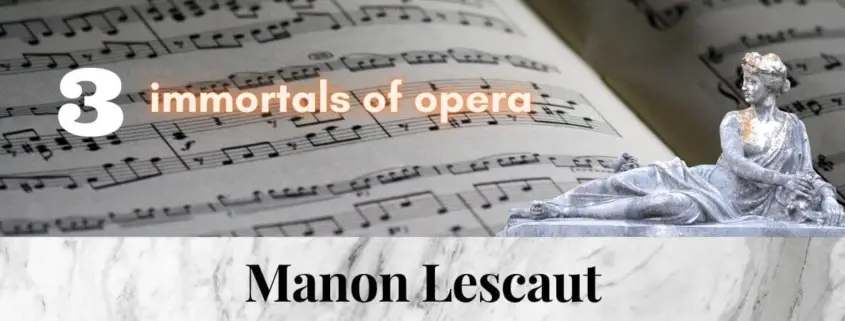“Manon Lescaut” is the opera that made Puccini a star in the operatic sky. The work overwhelms the listener with motifs and melodies and never was he closer to the music of Richard Wagner than here. With “Donna non vidi mai”, the Intermezzo and the Love Duet, Puccini wrote iconic pieces.
Des Grieux is in love
The following aria is the most famous piece of this opera and the first famous aria written by Puccini. The ¾ time signature gives the piece a lilting, dreamy character. The orchestral accompaniment of the melody is very rich, the tuning of the accompanying instruments with divided strings spans several octaves, emphasizing Des Grieux’s passion with notes in extreme registers. Des Grieux’s emotional aria returns the romantic motif of the violins that sounded when he addressed Manon.
In the second part, Des Grieux tenderly and rapturously quotes Manon’s motif “Manon Lescaut mi chiamo” over and over again, with which she had introduced herself. It is a surprising effect that makes this aria seem almost like a duet. The third part, “O susurro gentil, deh! Non cessar!” is repeated several times and ends this aria with a passionate high B sung with verve.
Björling was able to bring both Des Grieux’s passion and his vulnerability equally to the voice.
Donna non vidi mai – Björling
Des Grieux appears – the great love duet
With a cry of surprise, a long, passionate duet begins. Des Grieux accuses her of fleeing, ever more desperately he cries “Taci” in response to her rebuttals. Manon begs for forgiveness accompanied by a beautiful motif that we will not hear for the last time:
With this tender motif, she breaks Des Grieux’s resistance. With the words “Ah, vieni! colle tue braccia stringi Manon” sung with Des Grieux’s melody of “Donna non vidi mai” she breaks his last resistance. Des Grieux retorts with a Wagnerian motif that will gain an important meaning in this opera, that she is his fate (In the depth of your eyes I read my fate).
With the joint repetition of this motif, accompanied by the jubilant orchestra, this long-strung duet ends in a tumultuous embrace.
We see and hear this scene beautifully played and sung by Plàcido Domingo and Renata Scotto. Both singers excelled not only in their formidable vocal artistry, but also in their acting. This excerpt, conducted by James Levine, was from the Met’s first live broadcast of an opera to Europe in 1980 and was a sensation. Domingo’s opulent, passionate voice had contributed to it.
Tu, tu amore, tu – Scotto / Domingo
The Intermezzo
After her arrest, Manon was sentenced to be deported to a penal colony in Louisiana. She is in prison in Le Havre awaiting the ship that will take her overseas.
Puccini composed the feelings of despair of Manon and des Grieux over the tragic events with this grand intermezzo. It begins with the desolate cantilena of a viola. Gradually, other instruments enter and the orchestra leads into the wonderful main theme of the intermezzo.
This theme is performed over a longer period of time. At the end, the mood of the piece changes and Puccini presents the almost ethereal final motif, the so-called fate motif, which is heavenly colored by the woodwind sound:
Intermezzo – Pradelli











Leave a Reply
Want to join the discussion?Feel free to contribute!